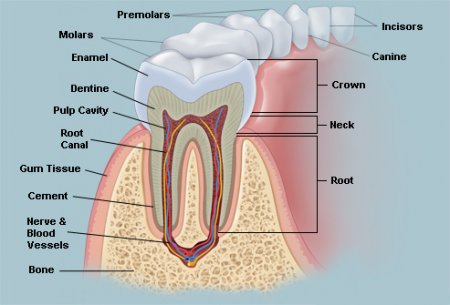The teeth
- Category: Digestive system
- Views: 8148
By the shape the teeth are divided into:
- incisors - have one root, wedge-shaped crowns, particularly upper incisors crown shape has the spatula, lower - bits;
- canines - have one root, crown conical shape;
- premolars: upper premolars have bifurcated root, on the horizontal cut their crown has oval shape; hills are almost identical; lower premolars have one root, on the horizontal cut their crown has round shape, vestibular hill is large, oral - smaller;
- molars: upper molars have three roots (two vestibular and one oral), diamond-shaped crown; lower molars have two roots, square shape of crown.
Adult human has 28-32 permanent teeth. Child has 20 milk teeth.
Teeth are located in the mouth.
External structure of the tooth.
The tooth consists of the following parts:
- Crown. Distinguish the anatomical and clinical crown.
Anatomical crown - part of the tooth that protrudes above the edge of the tooth alveolus. Clinical crown - part of the tooth, which protrudes above the edge of the gums;
- The root of the tooth;
- The neck of the tooth;
- The tip of the tooth.
Inside the tooth is a cavity, which goes to the root canal of the tooth. The surfaces of the tooth:
labial:
- Vestibular;
buccal:
- Oral or lingual;
- Contact or lateral - aproksymal mesial, aproksymal distal;
- Chewing.
Determination signs of right or left tooth:
- A sign of the crown angle (in vestibular norm the angle, which formed by the medial and occlusal surfaces is sharper);
- A sign of the crown curvature (in chewing norm the medial part of enamel is more convex on the vestibular surface, medial edge has steeper slope);
- Root sign (in vestibular norm the longitudinal axis of root deviates laterally).
The internal structure of the tooth
The tooth consists of the following tissues:
- dentin - determines the shape of the tooth. 72% of dentin - is an inorganic substance. Dentin consists of dentinal tubules, in which are processes of cells (odontoblasts). Odontoblasts located in the pulp. The structure of dentin consists of collagen fibers (tangentially located in the pulp dentin and radially in coat dentin), gluing substance.
- enamel performs a protective function. 97% of enamel - is an inorganic substances. Enamel is composed of enamel prisms.
- cement performs a protective function. Cement is divided into primary (acellular) and secondary (containing cells). Cement consists of collagen fibers and inorganic substances that make up 70% of cement. Cement has no blood vessels and feeds on by diffusion from the side of a periodontium.
- pulp - is a loose connective tissue, rich in cells (pre-odontoblasts, odontoblasts, fibroblasts, fibrocytes), blood vessels, nerves; performs trophic function. Enamel covers the crown of the tooth, cement - the root of the tooth, pulp contains in the cavity of the tooth.
Dental organ – consists of tooth and periodontium. Periodontium - is a tissues that surround the tooth, including:
- periodontium;
- dental alveolus;
- gums;
- cement.
Periodontium - is a connective tissue membrane of the tooth, located between alveolus dental and cement. Periodontium consists of:
- Collagen fibers;
- Vessels;
- Nerves;
- Cells (osteoclasts, osteoblasts, fibroblasts, fibrocytes, cementoblasts that form secondary cement);
- Loose connective tissue.
Periodontium functions:
- Fixation of the tooth;
- Amortization;
- Trophic function;
- Protective function (protection from infections against overloads due to baroreceptors, located in periodontium);
- Cambial function - performs due to the presence of periodontal osteoblasts, osteoclasts, cementoblasts.
Tooth alveolus includes periosteum of the alveolar process and bone wall of dental alveolus.
